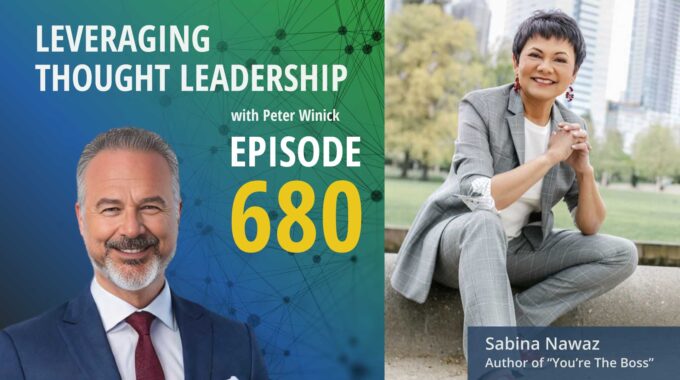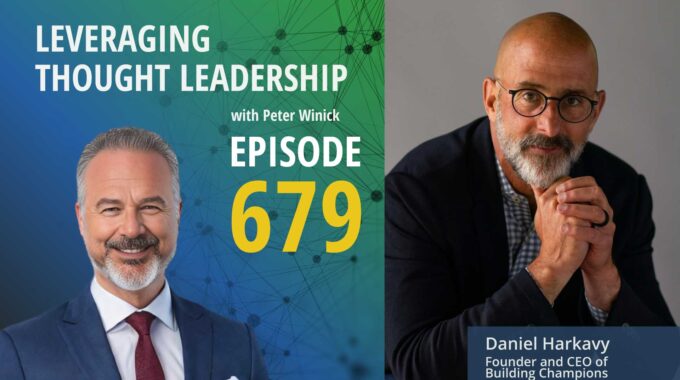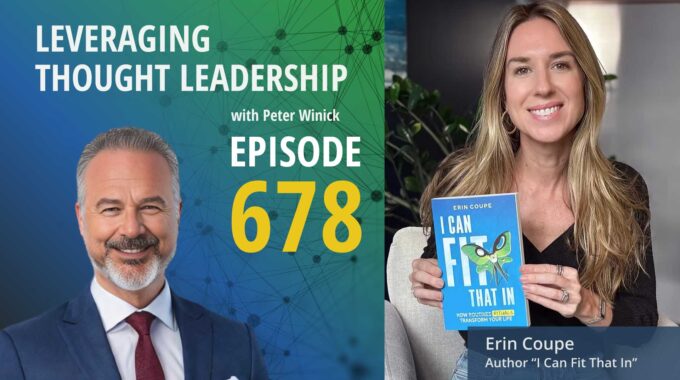Coaching at the Top, Leveraging AI, and Playing the Five-Year Book Game This episode explores…
Leveraging Thought Leadership With Peter Winick – Episode 168 – Rita McGrath

Too often, racial, gender, sexual preference, or other personal qualities become the end-all, be-all of how people see us — when, in actuality, it’s a thought leader’s knowledge and expertise that deserves attention. So, how do you avoid being forced into a “niche” simply because of your personal identity?
We’re proud to present our guest in this episode, Rita McGrath, best-selling author of Seeing Around Corners. She’s a sought-after speaker, a professor at Columbia Business School, and her writing is regularly featured in the Harvard Business Review. As a leader for innovation and growth, Rita was one of a small group of experts who built today’s best-in-class innovation practices, and her tools around innovation were integral to the foundation of the “lean startup” movement.
Rita joins us for an insightful conversation around the challenges and opportunities of being a female thought leader, author, and speaker. She shares personal experiences, and talks about being too often relegated to the role of “women’s leadership,” rather than being recognized for her top-quality knowledge and content — innovations that work regardless of gender.
You want to be known for your ideas — not your personal identity. We can help! Check out TLL’s great tips for building a clear thought leadership brand.
Transcript
Peter Winick And welcome, welcome, this is Peter Winick. I’m the founder and CEO of Thought Leadership Leverage and you’re joining us on our podcast today, which is Leveraging Thought Leadership. Today, my guest is Rita McGrath. Rita Gunther McGrath is a best-selling author, a sought-after speaker, a long-time professor at Columbia Business School, and she’s widely recognized as a premier expert on leading innovation and growth during times of uncertainty, which I think most times are. She’s consistently been in the top 10 on the Thinkers 50s list. She’s written several books. Her latest, which just came out recently, and I had the pleasure of finishing a couple weeks ago, is called Seeing Around Corners, How to Spot Inflection Points in Business Before They Happen. So welcome aboard, Rita. How are you today? It’s a pleasure to be here. Thank you for having me on. Great. So one of the things I wanted to talk to you about is you’ve been in an interesting place where you’ve written some books as a co-author and then you’ve written them solo. So not that one is necessarily better than the other, I would say they’re different, right? But maybe talk about the pluses and minuses and differences in going co-versus a solo authored piece.
Rita McGrath Sure, so let’s talk about the content, but make that separate from the PR and how people regard the book, because these are two different things. I think the great thing about having a co-author if you’re developing content is it gives you a sparring partner. It gives you someone to bounce ideas off of. Sometimes they have a strength or an area they know about that you don’t, so that can be very helpful. So from a writing process perspective, that’s the good part. The bad part is, you know, you can lose arguments. You can disagree about how things should go. You can sometimes find you’re getting held up because there’s something that just isn’t gelling between the two of you. I mean, anything involving human beings. When you sole author, I think your relationship with your editor then becomes much more primary. You’re not so much working with another peer, you’re working with an editor who’s got editorial judgment and they’re really speaking for the reader. Sure. And so that’s.
Peter Winick quite a different relationship. What about alignment with the co-author? Because I’ve seen some cases where. it’s gone amazingly well, where a group of co-authors are totally passionate and aligned. And I’m thinking, for example, of Adrian Gostick and Chester Elton. They’ve been together a long time as co-author. They have very different skill sets, but it’s been a long-term partnership. And then there’s others who I won’t name by name, where it’s been sort of a rocky road, a bad marriage. It’s ended in the equivalent of divorce, post-facto. And usually the root cause is there’s a lack of alignment around, I’m writing this book for X. What questions, or if you were talking to folks and advising folks that came to you and said, hey, we’re gonna co-author a book, are there some things that you would throw at them to say, well, consider these to make sure that you should do it together? Exactly.
Rita McGrath Well, you know, you’ve got the question of what’s your goal. And if they’ve got different goals, that’s a red flash from the beginning. Then are they clear about who’s going to take on what role? I mean, one of the things my co-author used to do that used to drive me absolutely bonkers was he’d write like one page of text and then hand it to me and say, well, you type really quickly. Why don’t you turn this into a tag? And I’m like, that’s not the way we’re going to play this game. So, I think those kinds of questions about working style and what do you like to have individual chapters or do you to have the whole superstructure before you dive into the detail? I think the other thing that I think is really crucial is time. We all have different time demands. We all different ways of working. And if your ways of work are incompatible, that can make you crazy.
Peter Winick And those are sort of non and sometimes you don’t know that what you know the things that the partners doing that makes you crazy you have quirks as well and because writing is typically, you know an individual sport and now you move from a team sport it’s like going from paying you know singles to doubles and tennis like it’s just not for every
Rita McGrath Well, that’s right. That’s right and the other thing, though, that I would like to mention to your audience, whom I know, I would imagine quite a fair number of women, is if you’re a woman and you write with a man, that is a very dicey proposition. And there was some fabulous research done at Harvard of economists and what each additional article did for their chances at getting promotion, chances of winning tenure. And for men, it really didn’t matter what the co-authoring was. For women, there was no impact if you wrote by yourself or if you co-authored with another woman. But if you met, if you write with a man, zero credit. Like zip, zero zelch, the statistical effect completely disappears.
Peter Winick Really? So is it the assumption that the man wrote, like the man did all the work or what? That seems crazy to me.
Rita McGrath Well, doesn’t it? I know. If I had been listening to my younger self hearing this on a podcast, I would have said she’s crazy. This is 2019. Come on. I don’t think it’s conscious. I don’t people sit there and go, oh, well, you must know the work. But I do think there is a difference as a woman when you write by yourself or you write with another woman. It’s just a different way the world hears your voice.
Peter Winick That’s sad. So let’s go down that path for a minute, because… In my world, in my business, I would say 60, maybe 65% of my clients are female, which is not representative of the market, right? So if we break that market to say, well, the speaking market, I wouldn’t argue that the speaking market is probably not by volume of speeches done, not people volunteering to speech, maybe 20% female. You would know better than I, but at the university level, how many female professors are teaching at top business schools like Columbia, it ain’t 60%. Now, so… you know, let’s talk about some of the unique challenges and opportunities that women have as authors and thought leaders and speakers, because there’s good and bad in everything, typically. Sure. So, share with us some of your experience. Obviously, you’re a tenured professor at Columbia, not chopped liver, as we say, right? Like, so that’s interesting. What has been, maybe let’s start on the negative and end on the positive, some of challenges of being a woman in this world of content and thought leadership.
Rita McGrath Well, I think it’s the challenge that any minority group faces, which is, you know, people don’t know what to do with you. They don’t have a neat category to put you in. And so there’s a there’s a question of having to carve out to make it easy for them to carve and recognize what it is you do. I think that’s one thing that is harder if you’re a member of a minority group. They can’t just pitch it for you. I think one thing that your readers really need to bear in mind if they’re serious about this. Secondly, you have to really find your own style. And I’ve known a number of women that struggle with this because if you’re in the minority group, and in this case, I’m talking about women, but it could also be if you are an unrepresented cultural or ethnic minority person, and it gets worse if you both. Right. You have a much narrower range of acceptable behavior or acceptable jokes, acceptable behavior on the stage. So I’ll give you a specific example. You may remember Ian McMillan. Sure. Who’s my co-author for years and years. Yep. And the guy that always talked about how I typed so fast. But he would tell a joke, you know, about the business logic of business class, right? And he would say, oh, you now, and I’ve tried many times to make up the difference in the price between business class and regular class with the free drinks they give you and everybody yucked up and that’s all great. Well, I told that joke, people would be horrified. So the way I could tell a joke like that is to say, oh, and I’m here to tell you, my husband just tried many times to make up the difference in free drinks and it’s not a pretty sight. Really? Yeah, so for your women listeners, you really need to get coaching on where for you those lines are. Because if you’re too friendly and approachable and warm, you’re lightweight, and you’re really aggressive and convinced of your point of view, you’re abrasive or worse. Um, and so I think there just is a whole different thing. And I don’t think it’s inherent to women or not. If I was giving this advice to a man presenting to like the committee of 200 or something, I’d be saying the same thing.
Peter Winick If you’re enjoying this episode of Leveraging Thought Leadership, please make sure to subscribe. If you’d like to help spread the word about our podcast, please leave us a review and share it with your friends. We’re available on Apple Podcast and on all major listening apps, as well as at thoughtleadershipleverage.com forward slash podcast. So let me ask you this. One of the things that I’ve seen and done with my work with a lot of clients is there are opportunities that women and other minorities have. that men don’t. So for example, most Fortune 500s have some sort of a women’s leadership group or, you know, various diversity organizations. And one of the things I’ve realized in working with a lot of female clients is first impressions matter. And the first touch point that you have with a client, so let’s say it’s, you know Fortune 50 company acts and they invite you into the women’s group and you come in and do a great bang up job and standing ovation and people are impacted, blah, blah. The odds of being taken seriously and moving that from a speaking engagement to a full enterprise scale engagement is fairly low because they Typically, the organizations are not looking at the diversity groups for strategic insight on, you know, for drivers on how to run the business. So what I’ve told many clients is, listen, if you’re going to do those events, you make sure that whoever owns the P&L is in the room, male, female, purple, green, orange, it doesn’t matter. And make sure you get the introductions to the business folks. And you’re not just perceived as, oh, that’s someone that does a women’s, air quotes, women’s leadership thing.
Rita McGrath I would agree. I mean, I got dragged kicking and screaming into the world of women’s leadership, because as you know, my world has always been strategy, innovation, strategic inflection points. How do you think about things under uncertainty? That’s the world I live in.
Peter Winick And your writing is, I don’t want to say genderless, but you’re not coming at it from any particular, I mean, it’s strategy. Strategy is strategy. It doesn’t have a gender.
Rita McGrath what I always thought. But you know, as it turned out, the world has its own mysterious plans for people. And Columbia decided a few years ago to really make a commitment and this actually preceded me too. But I think me too definitely accelerated this to really try to do something for our executive women. So I now do direct a program on women in leadership. But I make it very clear, I’m doing it because I think it’s a really important topic, but not because it’s my subject area. And it’s not that I think it’s bad subject area, if that’s your thing, go for it. But it doesn’t have to be my thing. Yeah, no, no that’s true. But I would agree with you. There are a lot of really easy entry points to companies which either get you sidelined as. you know, one of those diversity people, or maybe you’re one of those supply chain people, there’s a lot of ways to get sidetracked. And it’s not just being, you know in the diversity groups, there are other, I’ve seen people come in into the project management area, for example, of a company and they know how to get out.
Peter Winick Right and you have to think about who whatever door got you into the company and whoever walked you through that door is going to have an impact on your reputation inside of that company that may be quite different than your professional or larger scale reputation right so if you’ve got you know walking through supply chain your tag is a supply chain person even if there’s nothing to do with the core of your content but it’s guilt or you know. not necessarily negative, you know, by association of whoever brought you in there. And if you have, you know leadership that doesn’t really like supply chain folks, that’s a strike. Absolutely.
Rita McGrath And I think the other thing that’s really valuable to remember is that, you know, the people that bring you into a company have their own goals and motivations. And I find, especially younger speakers, let’s say that speakers, younger speakers get so excited. Oh my God, I’m getting invited to talk to, you fill in megalithic corporation XYZ. They don’t think enough about, you what is that person really trying to accomplish by having me there. And you know, sometimes it’s not all sweetness and light. They could be wanting you there for a very specific purpose that has that great alignment of your agenda.
Peter Winick I’ll add to that, one of the things that I’ve seen is you might have someone internally that’s been advocating for X and nobody’s listening to them and then your body of work represents X so they’re bringing you in as a third party, puppet’s probably not the right word but a third-party confirmation that X is valid but they have a very strategic and calculated reason while they’re bring you in at this meeting at this point in time to make a deliberate point And I think sometimes. You know, we fail to look at that and we’re focused on, here’s our content and here’s the audience and whatever, but sort of reading the tea leaves here, why now and why this content? What have they done before? Is this aligned with what they’ve traditionally done? Is somebody trying to make a point, et cetera?
Rita McGrath Well, and it can really stand to your benefit, right? I mean, I’ve had that a lot where I get brought in, and I guess I’m known for being able to communicate somewhat difficult ideas in an approachable way, right. So, you know, I was like, okay, this is the reality of competition today, but it doesn’t have to freak you out. Here’s four or five ways of thinking about it. And if you have alignment with the person who’s inviting you, that can actually work out incredibly well. Peter, one of the things that I think is useful to think about is very often those people are HR people who come in from the business. So they’re being handed HR because that’s one of the few sources of competitive advantage left. They’re business people so they have a good sense for strategic thinking. And they’re one of few that has oversight over the whole business. They’re like, oh my goodness, we really need to be thinking differently. And then they actually will partner with you. Sometimes I’m casting that message. That can be a wonderful partnership.
Peter Winick So let’s talk about that from the perspective of, how do you come in as that expert, maybe your entree into an organization is a keynote or a talk or something at some event that they’ve got on their calendar. How do you take that and move that into a larger impact engagement? Additional services, be that video, be the digital, be that additional consulting, how do sort of penetrate further into the client to serve them?
Rita McGrath Well, I actually don’t tend to do that that much, mainly because for me to do ongoing hands-on consulting as an individual doesn’t really make sense. What I will do sometimes, depending on the client’s need, is we’ll think about the opening keynote for the top 200, let’s say, and then there might be a series of follow-ups, which could be a webinar series or something else. And usually what that is is it’ll be an expression of someone on the client side that says, wow, I really need more of my people thinking this way. And so we’ll go into that. But I think there is a difference between thought leaders that sort of come in and do the dramatic, and those that are really in there to have an ongoing series of engagements. I think it’s two different businesses.
Peter Winick Yeah, well, let’s talk about that. So the traditional keynote, right, maybe something more on the motivational end of the continuum, and by the way, it doesn’t mean other keynotes can’t have some element of that, is really designed to be engaging and inspiring and motivational and people go into the lunch feeling hip hip hooray and we can conquer the world and all that. But it’s not designed to get you to change the way you think, behave, look, act, believe against a set of business obstacles, right? It’s just different. It’s maybe junk food versus something nutritious or something. Well, you know, we could talk about the world, the world not being fair, because some of the motivational folks tend to make a ton of money. But I think that’s true where you talk about that they’re different businesses. The first being fairly, you come in, make people feel great. And then, you off to the next piece versus others that are more business savvy and can actually use speaking to help the client crack the code on something.
Rita McGrath Yeah, and I would say I’m really a big believer in internal capability building, and where I get a little concerned when I hear consultants talk about, you know, well we want to get the next engagement, we want the next thing, is I would do that but in the service of the client being independent when we’re through all this process. Sure. So I think, you know, it’s a question of how do we get a critical mass of people to be thinking and operating differently.
Peter Winick Well, I think that’s a philosophy in a business model. So there’s nothing wrong with consultants looking for the next engagement, assuming they’re providing value and leading the client better than when they got them. Another way to do that is to say, hey, I’m in the business of developing, helping you develop those internal capabilities to make myself obsolete, or so that you only come back to me in cases of extreme need, but there’s no black box here. This is teachable. Let me show you how to do it. How do you do that?
Rita McGrath Yeah, and I’m more on that side. Now, one thing I am doing, Peter, that’s new is I’m developing some instrumented software tools. Because of this exact problem, there’s just such a huge gap between, people come to my talk, they hear the ideas, they go, oh, we could do this, right? And then it’s kind of like they have to go back to their desk and invent practices themselves. So one of the things I’m doing, and we’re in beta right now, is developing a suite of software tools which guide people through, okay I’ve heard about, let’s just, an example I’ve heard about how to organize your opportunity portfolio for growth, now I want to go do that, but I don’t know how to do that. So I start with the pen and paper, I look at Rita’s notes, I scratch my head. So what our hope is with the software is it becomes almost an operating system, so that there’ll be like a training capability building layer next to it, but then the tools help make it really easy for you to have this way of moving. I’m super excited about that.
Peter Winick Well, I was going to say that that also plays into sort of in a macro level, what’s going on in adult learning, which is pull versus push. So a tool, I’m going to take that off the shelf right now when I need to do X and I need that tool that can help me do it versus pushes, you know, turn on the fire hose and pour lots of content and knowledge into my brain and hope that I retain it at the point that I need it, which is a bit of a risk to say the least.
Rita McGrath Yeah, I mean, I can see, you know, and for years, of course, I’ve taught courses at Columbia, I taught my own courses, and those are valuable, incredibly valuable for the networking and the break and the, you know, get away from the emails for a while. But I do think a lot of this much more practical and applied learning is going to happen in bite-sized chunks. In fact, ironically, I’m just back this morning from a keynote speech at a company called Big Read. Oh, yeah. And Degree is one of those next-generation learning platforms where you sort of sit on top of your learning management system and one of the things they do that’s I just think super cool, and I mean there are a number of these providers I just happened to have on my mind, but you can actually get credit for having read up a Fast Company article or having taken a quiz that’s on the platform and they have a way of instrumenting all that so that you can see in the company where people are investing in skills. The learner can do a lot more to drive it themselves. And they can actually do an assessment of, hey, you know, you’re doing great on these six things. There’s these other things that you really haven’t gotten down top of. And if you’re after this next role, here’s the three things you really need to improve on. So tying together the learning with what people are trying to accomplish with the learning to what they’re trying to accomplished for themselves.
Peter Winick I love that.
Rita McGrath I think that’s got to be the way the world is going.
Peter Winick Yeah, well, it’s self-directed. It’s an individual learner path. You and I both might need to crack the same code, learn the same thing. But maybe our styles are different. Maybe the situation is different. Maybe the context by which we’re deploying that skill is different, and we used to live in a one-size-fits-all world, and then we just don’t need more, which is really cool. So as we start to wrap up here, any final thoughts here in terms of Guidance to folks that are out there as authors and thought leaders, academic speakers, et cetera, trying to make a difference and get their content out in the world in meaningful ways. Any other reflections on that?
Rita McGrath one big breakthrough for me was that one of my colleagues had me teaching, she was the director at the time of our advanced management program at Columbia, which is our super duper top of the line you know program, and she very kindly offered to videotape me during this session and then a few days later we sat down and we went like frame by frame through that video, it was awful, it was so helpful because having somebody that… You know, it’s almost impossible to see yourself from that perspective. And so she would take a little bit of content that I was using, and she’d say, look, Rita, if I were you, this is how I present. And that kind of feedback is so helpful. So I’d say to your folks, especially the ones just getting started, if you have someone in your network or someone who you can turn to give you that really honest feedback and. and make it real you know make it an actual session where you’re videotaped and see what you’re actually doing because it’s we all have habits you know and until you become aware of them you can’t really change so that was one big turning point for me that was super useful excellent I will say the other big turning points was writing my writing on my own uh you know writing my own book without a co-author that, for me, made a big…
Peter Winick Excellent. Excellent. Well, thank you so much for being on board today. I have been a fan of your work for a long time, so it’s an honor to have you here, and I appreciate the conversation and the candor, and there’s lots of wisdom bouncing back and forth here today. So thank you so much, Rita. I appreciate it.
Rita McGrath It’s a pleasure.
Peter Winick To learn more about thought leadership leverage, please visit our website at ThoughtLeadershipLeverage.com. To reach me directly, feel free to email me at peter at Thought Leadership Leverage dot com and please subscribe to Leveraging Thought Leadership on iTunes or your favorite podcast app to get your weekly episode automatically.




